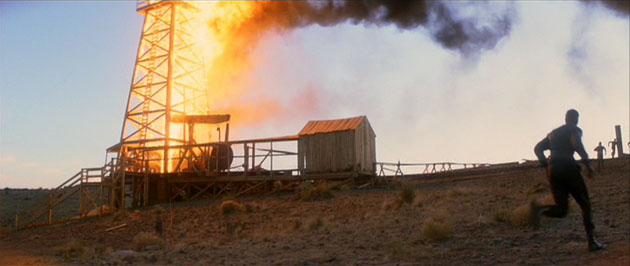Jack Fisk

AS: When working on The Thin Red Line would you ever show Terry pictures of bunkers or anything?
JF: We would look at research. I had so much research on The Thin Red Line. When we left Australia to shoot in Guadalcanal I had 35 boxes of documentary tapes, research books and government pamphlets and so on. I left it all to the WWII museum in Guadalcanal. That was an easy film to research. I live right near Washington DC and I went to the military museum there and the military bases in Virginia gathering information on the period.
I found the original manufacturer of the army uniforms and some of the original fabric. We used the same patterns the military used during the war. We even ordered the uniforms the same way the army did, not knowing what size the actors were going to be. I asked, What would the army normally order? 60% medium and 10% large? We outfitted like a real army.
I got to Australia and they didn’t have period airplanes. We found one DC 3, but I needed some fighting planes. In a museum in Queensland they had a Bell Cobra and they allowed us to come in and make a rubber mold of it which we cast in fiberglass. And that gave us our Bell Cobra. The welders built a frame for it and landing gear. We actually put motors in some of our airplanes and had props that would spin around.
We needed some Wildcats because those are the planes coming off aircraft carriers so we got a big, wooden kit for a radio-controlled Wildcat and we just enlarged it to full scale. We built them just like a model airplane, but at 100%. We built five of those.
We built landing craft, the Higgins boats, out of plywood and Styrofoam. In the end we were able to get two real landing craft to complete our fleet. You’ll see a lot of them out there. Some of them are CGI and some of them were plywood with Styrofoam bottoms with an outboard motor hidden inside. We built half of a landing craft that we put on a gimbal and set out in a field in Port Douglas. Whenever an actor was finished or going back to the States, Terry would get them into the half landing craft and he’d shoot a scene with them. We’d be throwing buckets of water over the side. It was really analog, old-timey but it was fun.
We built a pillbox for the Japanese up on top of a hill but it was so steep that we couldn’t get a backhoe up there to dig the hole. Art director Ian Gracie found a guy who’d won a competition with one of those little Bobcats. He got him to come up and dig the hole because the Bobcat was much smaller and he wasn’t afraid of falling off the mountain. He would dig and dig, smoke a joint, and then go back to digging. He could pick a coin up off the pavement with his Bobcat bucket. And he didn’t even use a ramp to get it on the truck. He was gifted.
Pingback: K.K. Barrett
Pingback: Laurence Bennett
Pingback: Adam Stockhausen
Pingback: Colin Gibson